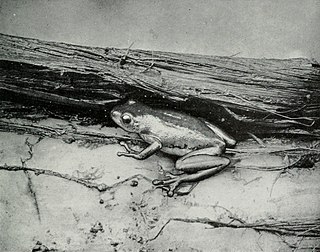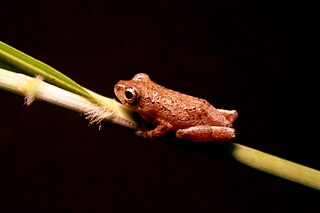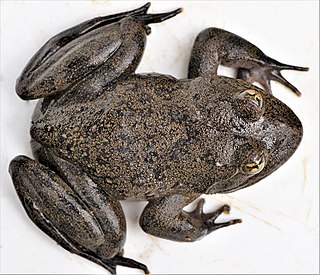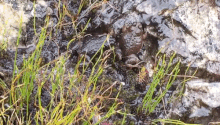
Callulina is a small genus of frogs in the family Brevicipitidae with nine members in Tanzania and Kenya. Originally Callulina was thought to be monotypic and widely distributed through Eastern Arc Mountains in Tanzania and in southern Kenya. However, within the last decade eight new species has been identified, the majority of which are considered critically endangered by the International Union for Conservation of Nature (IUCN).
Werneria tandyi, also known as Tandy's torrent toad or Tandy's smalltongue toad, is a species of toad in the family Bufonidae. It is endemic to western Cameroon and known from Mount Manengouba and from the Rumpi Hills. The specific name tandyi honours Robert Mills Tandy, biologist, herpetologist, and wildlife photographer.

Agalychnis saltator is a species of frog in the subfamily Phyllomedusinae. It is found in the Caribbean lowlands from north-eastern Honduras through Nicaragua to east-central Costa Rica at elevations of 15–1,300 m (49–4,265 ft) asl. Its common names are parachuting red-eyed leaf frog and misfit leaf frog.
Hyperolius bopeleti, also known as the Dizangue reed frog or Bopelet's reed frog, is a species of frog in the family Hyperoliidae. It is endemic to the coastal southwestern Cameroon. The specific name bopeleti honours M. Bopelet, a Cameroonian biologist.

Hyperolius picturatus is a species of frog in the family Hyperoliidae. It is found in northern and eastern Sierra Leone, southern Guinea, Liberia, Ivory Coast, and Ghana; its range might extend to Togo. Common names coined for this species are Tanzania reed frog and variable montane sedge frog.

Hyperolius spinigularis is a species of frog in the family Hyperoliidae. It is found in the Mulanje Massif in southern Malawi and the Namuli Massif in adjacent Mozambique. Records from Tanzania refers to other species. Males of this species have characteristic small spines during the breeding season. Its common names are spiny-throated reed frog, spiny reed frog, and Mulanje reed frog.

Hyperolius tuberculatus is a species of frog in the family Hyperoliidae. Its common name is rainforest reed frog. It ranges from the southeastern Nigeria to the Central Africa in Cameroon, western Central African Republic, Equatorial Guinea, Gabon, Republic of the Congo, and Democratic Republic of the Congo. It is also likely to occur in the Cabinda enclave of Angola.

Leptopelis aubryi, also known as the Aubry's tree frog and Gaboon forest treefrog, is a species of frog in the family Arthroleptidae. It is found in southeastern Nigeria, Cameroon, Central African Republic, Equatorial Guinea, Gabon, Republic of the Congo, western and northern Democratic Republic of the Congo, and Angola.
Leptopelis nordequatorialis, also known as the West Cameroon forest treefrog, is a species of frog in the family Arthroleptidae. It is found in central and western Cameroon and eastern Nigeria. It is closely related to Leptopelis anchietae and Leptopelis oryi.

The desert rain frog, web-footed rain frog, or Boulenger's short-headed frog is a species of frog in the family Brevicipitidae. It is found in Namibia and South Africa. Its natural habitat is the narrow strip of sandy shores between the sea and the sand dunes. It is threatened by habitat loss by such factors as mining and tourism.

The Mazumbai warty frog is a species of frogs in the family Brevicipitidae. It is endemic to forests of the West Usambara Mountains of Tanzania where it is threatened by habitat loss. It is part of a species complex and was recognised as a separate species in 2004, having previously been included in Callulina kreffti.
The Bainskloof moss frog or Bainskloof chirping frog is a species of frogs in the family Pyxicephalidae. It is endemic to South Africa.

The micro frog, or Cape Flats frog, is a species of frog less than 2 cm (0.8 in) long in the family Pyxicephalidae, in the monotypic genus Microbatrachella. Its color varies from rufous brown with dark mottling, to tan or green, depending on the population. It is endemic to the south-western Cape area of South Africa, with a single population found on the Cape Flats of Cape Town and several populations on the eastern side of False Bay. It typically lives in wetlands in coastal fynbos habitats, but its total area of occupancy is very small, and the International Union for Conservation of Nature has rated it as being "critically endangered".
Phrynobatrachus gutturosus, the Chabanaud's river frog or guttural puddle frog, is a species of frog in the family Petropedetidae. It is found in Democratic Republic of the Congo, Ivory Coast, Ghana, Liberia, Nigeria, possibly Benin, possibly Burkina Faso, possibly Guinea, possibly Mali, possibly Togo, and possibly Uganda. Its natural habitats are subtropical or tropical moist lowland forest, moist savanna, swampland, and intermittent freshwater marshes. It is threatened by habitat loss.

The Natal dwarf puddle frog is a species of frog in the family Phrynobatrachidae. It is found in Angola, Benin, Botswana, Burundi, Cameroon, Central African Republic, Republic of the Congo, Democratic Republic of the Congo, Ivory Coast, Eritrea, Ethiopia, Gambia, Ghana, Guinea, Guinea-Bissau, Kenya, Liberia, Malawi, Mali, Mozambique, Namibia, Nigeria, Rwanda, Senegal, Sierra Leone, South Africa, Sudan, Swaziland, Tanzania, Togo, Uganda, Zambia, Zimbabwe, and possibly Burkina Faso, Chad, Lesotho, and Mauritania.

Amietia vertebralis, also known as Maluti river frog, aquatic river frog, ice frog, large-mouthed frog, or water frog, is a species of frogs in the family Pyxicephalidae. It is an aquatic high-altitude species found in Lesotho and neighbouring South Africa.

The African bullfrog is a species of frog in the family Pyxicephalidae. It is also known as the pixie frog due to its scientific name. It is found in Angola, Botswana, Kenya, Malawi, Mozambique, Namibia, South Africa, Tanzania, Uganda, Zambia, Zimbabwe, and possibly the Democratic Republic of the Congo. It has been extirpated from Eswatini. It has long been confused with the edible bullfrog and species boundaries between them, including exact range limits, are not fully understood. Additionally, P. angusticeps of coastal East Africa only was revalidated as a separate species in 2013.

The banded stream frog, also known as the banded sand frog, Cape grass frog, Cape stream frog, long-toed frog, mountain frog or Jonkersberg frog, is a species of frogs in the family Pyxicephalidae. It is endemic to South Africa.
Amietia hymenopus is a species of frog in the family Pyxicephalidae. It is found in the Drakensberg Mountains and Lesotho Highlands in northeastern Lesotho and adjacent South Africa. This species has many common names: Phofung river frog, Berg stream frog, Drakensberg river frog, Natal Drakensberg frog, Drakensberg frog, and Drakensberg rana.

Callulina dawida, also known as Taita warty frog, is a species of frogs in the family Brevicipitidae. It is endemic to Kenya, where it is only found in severely fragmented montane forests in Taita Hills in the south-eastern part of the country. Originally Callulina was thought to be monotypic and widely distributed through Eastern Arc Mountains in Tanzania and in southern Kenya. However, within the last decade eight new species has been identified, many which are considered critically endangered by IUCN. C. dawida was described in 2009 by a team led by Simon Loader; it received its specific name after Dawida language, which is spoken in Taita Hills.















